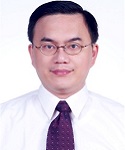
Prof. Bing-Yuh Lu
Guangdong University of Petrochemical Technology (GDUPT), China
Title: Formations of Coarse and Fine Crackle Sounds: A Perspective on Acoustic Transmission in Tissues
Abstract:
This study investigates the cause of crackle sounds by simulating a
one-cycle sine wave as a single burst of an explosive effect penetrating the human
chest wall. The findings clarify the differences between the definitions of
crackle proposed by Sovijarvi et al. and Reichert et al. Computer simulations
were used to synthesize lung crackles. Results show that coarse crackles occur
when higher burst frequency carriers (greater than 100 Hz) penetrate the
bandpass filter simulating the chest wall. These simulated coarse crackles were
characterized by a low pitch, high amplitude, and long duration, exceeding 10
ms. In contrast, a lower frequency carrier (approximately 50 Hz) had its
fundamental frequency component filtered out, allowing only the second harmonic
component to penetrate the chest wall, resulting in a fine crackle. From a
broader perspective, this communication system model supports one possible
explanation for the occurrence of normal breath sounds, wheezes, and crackles
using modulation and filter theories.
This research builds on a previous study that explored the
mechanisms underlying the generation of coarse and fine crackle sounds using a
sound transmission model. By employing this model and incorporating additional
physiological signals, the current study examines the time intervals between
successive bursts. It visually demonstrates that fine and coarse crackles
result from the timing of one-cycle sine wave bursts caused by airway
vibrations in the respiratory system. With each sine wave burst lasting 8.3 ms,
most observed crackles are classified as fine crackles (with a 2-cycle duration
(2CD) < 10 ms). Coarse crackles, which have a 2CD ≥ 10 ms, are produced
under specific conditions, such as increased noise and oscillations. Notably,
well-defined wave-shaped crackles are often observed in quieter conditions.
This study also investigates how timing affects the accumulation of output
responses during the formation of coarse and fine crackles, a phenomenon
difficult to detect in animal experiments. The key innovation of this research
is the computer model's ability to clarify the impact of timing on crackle
formation.
Keywords — crackles, computer simulation,
lung sound, respiration, amplitude
Biography:
Bing-Yuh Lu was born in Miouli, Taiwan, in 1964. He received his BS
in Electrical Engineering from National Central University in 1988, his MS in
Electrical Engineering from National Taiwan University in 1993, and his PhD in
Electrical Engineering from National Taiwan University in 2000. He is currently
a full professor at the School of Automation, Guangdong University of
Petrochemical Technology (GDUPT) in Maoming City, Guangdong, China, and serves
as the advisor of the Sensor and Control Lab within the School of Automation at
GDUPT. From 1993 to 2019, he held various positions at the Department of
Electronic Engineering, Tungnan University in New Taipei City, including
instructor (1993-2000), associate professor (2000-2016), and full professor
(2016-2019). Additionally, he served as director and invited associate
professor at the Department of Information Management, Catholic St. Mary Junior
College of Medicine, Nursing, and Management in Yilan, Taiwan, from 2011 to
2013. He has also served as an adjunct associate professor at the Department of
Business Administration, National Taipei University of Business in Taipei, from
2014 to 2017, where he supported undergraduate training for computer
applications license examinations. Furthermore, as a member of IEEE, he has
been part of the Technical Committee for the IEEE International Conference on
Advanced Communication since 2015 and has served as a reviewer for various
international journals. His academic interests include medical engineering, acoustics,
electronic circuits and systems, modeling, and signal measurement and
processing.